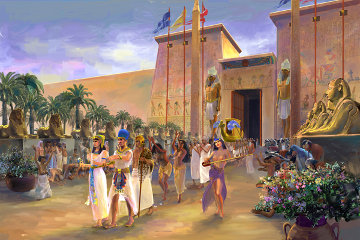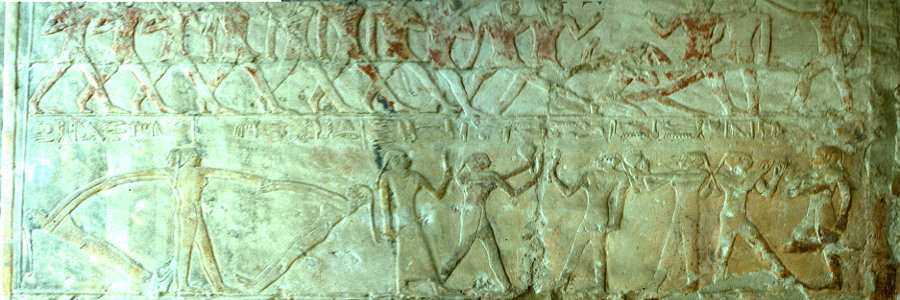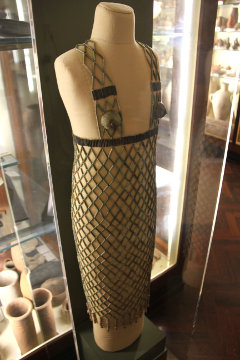An Egyptian Paedophile?
Herodotus claimed to have visited many countries in the course of his researches, but modern scholars now like to cast doubts upon his tales, pointing to discrepancies between things he claims to have seen with his own eyes and what are believed to be the facts on the ground. However there is one journey that everyone seems to accept and that is his visit to Egypt.
On the whole, Herodotus approved of Egypt, asserting that Greece was indebted to the Egyptians for the names of its gods as well as a host of other benefits. Egyptian medicine, wisdom, antiquity and religion all come in for approving mention, but there is one aspect of Egyptian life that Herodotus found rather shocking.
Concerning Egypt itself I shall extend my remarks to a great length, because there is no country that possesses so many wonders, nor any that has such a number of works which defy description. Not only is the climate different from that of the rest of the world, and the river unlike any other rivers, but the people also, in most of their manners and customs, exactly reverse the common practice of mankind. The women attend the markets and trade, while the men sit at home at the loom; and here, while the rest of the world works the woof up the warp, the Egyptians work it down; the women likewise carry burdens upon their shoulders, while the men carry them upon their heads. ...
The following are the proceedings on occasion of the assembly at Bubastis:- men and women come sailing all together, vast numbers in each boat, many of the women with castanets, which they strike, while some of the men pipe during the whole time of the voyage; the remainder of the voyagers, male and female, sing the while, and make a clapping with their hands. When they arrive opposite any of the towns upon the banks of the stream, they approach the shore, and, while some of the women continue to play and sing, others call aloud to the females of the place and load them with abuse, while a certain number dance, and some standing up uncover themselves and display their private parts.

| |
| An artist's impression of an ancient Egyptian festival. The naked women would appear to be authentic! |
Quite why the women behaved in this way is not clear, for we know from other sources that Egyptian men and women worked naked in the fields. Curiously, there is a picture in the Petrie Museum in London showing the great archaeologist at work surrounded by his workmen, one of whom is entirely naked. The Muslim culture of today ensures that the women no longer appear naked, but the Diggings tour has experienced this aspect of Egyptian life.
We were returning from Lahun and driving beside a canal. I was seated up the front by the driver, ready to resume my commentary as we neared Hawwara, when suddenly the bus tilted sharply to the left. The driver and I looked at one another and then he looked in his mirror and I turned my head to see the cause. All the women on the tour were over on the left side of the bus burning up the film like there was no tomorrow. It appeared that we were passing a party of men working in the canal and, no doubt because the work was wet and muddy and the day hot, they were working naked.
There is a curious reference to this nonchalant approach to nudity in the Bible, where the prophet Ezekiel tells an extended parable of Israel's unfaithfulness to God by relating the story of a man who found a girl-baby that had been thrown out - exposed - as unwanted. Out of the kindness of his heart he rescued the infant and took her home with him.
Then I passed by and saw you kicking about in your blood, and as you lay there in your blood I said to you, "Live!" I made you grow like a plant of the field. You grew and developed and entered puberty. Your breasts had formed and your hair had grown, yet you were stark naked. Later I passed by, and when I looked at you and saw that you were old enough for love, I spread the corner of my garment over you and covered your naked body.
Ezekiel 16:6-8

| |
| Children playing, from the mastaba of Mereruke, Saqqara. In the top register boys play soldiers; in the lower register girls play a variety of games. Notice that the girls are all naked except for one. |
If it seems odd that the girl should be kept stark naked well into puberty, we have a depiction of just such a situation in the mastaba of Mereruke at Saqqara. Mereruke seems to have been fond of children, for part of one wall of his tomb is given up to pictures of girls and boys at play. The boys, as you might expect, have formed a mock army and are marching up and down under the command of their "general".
The girls, on the other hand, are engaged in more peaceful games. One group is whirling each other around, their long plaits swinging; another couple are playing some form of hopscotch, while girls in the middle group appear to be holding either mirrors - dressing up? - or rattles. All of these children are completely naked - the well-formed breasts on the girls show that they are not toddlers - apart from one girl who is playing as hard as the rest but is wearing a long linen dress. Why she is thus favoured is not clear, but possibly, like the heroine of Ezekiel's parable, she has attracted the attention of Mereruke and is married, though still young enough to play.
If so - and guessing from her physical characteristics that she is probably in her mid-teens - she is lucky. The Petrie Museum in London has a couple of ancient Egyptian dresses retrieved by Petrie from tombs near Lahun. Made of linen, the thread is fairly coarse and the weave is correspondingly loose. I can remember my grandmother once remarking acidly on a young lady of whose garb she disapproved, "That material is so thin you could spit peas through it!"
You might not be able to spit peas through these ancient Egyptian dresses, but there is no doubt that if a modern woman were to wear one, the prudish press would position black squares over chest and groin to spare their readers' blushes! It is clear that the ancient Egyptians wore clothes for decoration, not concealment.

| |
| A "dress" made of blue faience tubes, in the Petrie Museum, London. |
In a case nearby is another "garment" which makes the point even more clear. Hundreds of thin blue faience tubes have been strung on fine thread to form a net and the net is carefully shaped, not for catching fish but to be worn. Tightly spread over smooth, brown skin the effect must have been most attractive but as each hole in the mesh was at least an inch square there was plenty of the afore-mentioned skin on display. The accompanying card notes that the "dress" is only large enough to fit a girl of eight or nine years of age.
As such a garment would have been damaged by any ordinary use - playing or working - it is obvious that it has but one purpose, which was to display its wearer's physical charms to best advantage. We may be horrified at the thought of such a young girl being made the object of sexual desire, but that is an attitude that is of relatively recent origin. Neither Mereruke nor the hero of Ezekiel's story were unusual in waiting until their girls reached advanced puberty before clothing them!
The Talmud, in the tractate Baba Kama, makes it clear that puberty - and marriageability - commenced when a girl had two pubic hairs. The Muslim prophet Muhammad married the girl Ayesha when she was only nine years old. Lest Christians think themselves superior, Henry II of England married a twelve-year old girl (who, incidentally, proved a far tougher and more determined figure than her husband!) and Isabel, the she-wolf of France, was the same age when she married Edward II. Other European monarchs married girls as young as nine (and were betrothed to children considerably younger!)
Today any such relationship would - rightly - be regarded as a criminal matter and some have claimed that Muhammad was a paedophile because Ayesha was so young. The charge is certainly false; there is no indication that Muhammad or any of the others I have mentioned had an unhealthy interest in young girls. Such marriages were not considered at all unusual, which is almost certainly why there is no minimum age for marriage specified in the law of Moses. It was simply not regarded as an issue!
We can but wonder at how many young girls paid the price of pregnancy at such a young age.
Some years ago the Diggings group was taken on a tour of the Rockerfeller Museum as a reward for digging through one of the hottest summers I have known in Israel. There we were addressed by Joe Zias who showed us, among other things, some glass bowls stained with a brown substance. They were found buried with the skeleton of a young girl of perhaps ten or eleven. Within her pelvis were the bones of a full-term foetus and it was obvious that the girl had been unable to give birth, because the infant's skull was larger than the hole in her pelvis. On a hunch Zias tested the brown stain with a police drugs kit and found that it was cannabis resin. His interpretation was that the poor girl had died in agony, which those about her had tried to assuage by filling the room with smoke from the marijuana being burned in the bowls.
Which makes it all the more remarkable that the law of Moses does not contain any prohibition against marrying a young girl. The closest we come to it is a law which forbids a man to marry a girl and her mother. These days our minds might boggle at the prospect of marrying our mothers-in-law, but there were advantages; you marry the daughter for her youth and beauty, you marry the mother for her wealth or social status. Alternatively you marry the mother and then you marry the daughter to avoid having to pay a large dowry!
It is, of course, possible that Israelite girls were not married off at a young age and the stipulations in the Talmud were the product of a later age and the perverse or even perverted imaginations of the sages. There would be no need to legislate in a matter which was already accepted custom. I fear, however, that such an ideal situation is probably unlikely.
There is, however, one factor that needs to be considered, and that is the age at which a girl became capable of pregnancy. These days European girls commonly enter upon puberty around the age of 9 or 10; two centuries ago the situation was very different. Girls born in the 1840s in Norway did not begin their periods until they were 17 and those in England reached the same stage a mere six months earlier! We need not consider the possible causes for this decrease, merely note its existence. There could be fewer physical objections to youthful marriage if there was little or no possibility of pregnancy until the girl had reached a more suitable age.
Today, of course, we are aware that children are not psychologically ready for sex and marriage (though we should never forget that that may be a cultural artefact. In a society where girls were routinely married at a young age the psychology may have been very different.) However there are other factors that should be considered.
Quite apart from poverty, which may drive some parents into marrying off their daughters as soon as possible, there is the question of life expectancy. Some have suggested that in ancient times the average life expectancy was as low as 36; if so it would clearly be an advantage for both sexes to start their reproductive lives as early as possible; even if you had your first child at 18, you would be unlikely to live to see your grandchildren!
Fortunately we live in better times and there can be no excuse for anyone who has sex with a child. The innocence of childhood is rightly valued and we have laws to protect it. Nevertheless, we should be wary about imposing our cultural values on previous societies; we may deplore the fact that Mohammed married a girl so young as Ayesha, without condemning him as a paedophile. We may regret the fact that Moses made no laws concerning the age of consent, without regarding it as an argument against his probity or inspiration.
As the old Red Indian proverb (allegedly) has it, Judge no man until you have walked a mile in his moccasins - or, in our case, don't judge the culture of a previous age until you have lived in it.
© Kendall K. Down 2019





